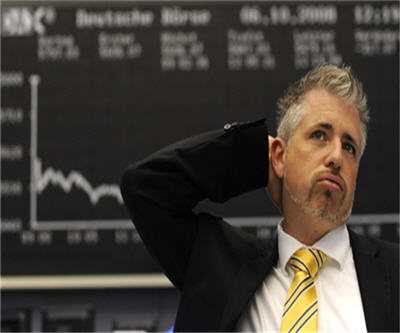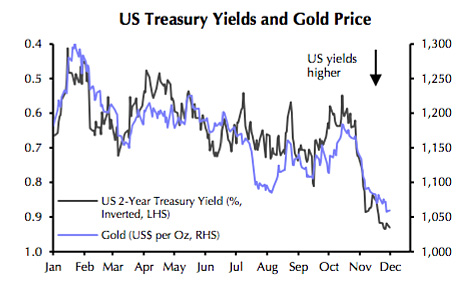
On Friday gold raced higher after a so-so jobs report in the US injected some doubts about the bearish case for the metal.
The number of US non-farm positions created in November came in at 211,000, down significantly from October’s nearly 300,000 jobs. The unemployment rate held at 5%, reflecting continued weakness in labour participation rates.
The slowing growth in employment won’t dent expectations that the US Federal Reserve would hike rates in December, but it was enough for gold bulls to take heart and send the metal 2.6% higher shortly after the announcement.
Gold futures with February delivery dates on the Comex market in New York hit a high of $1,088.85 early with contracts worth more than 19 million ounces exchanging hands, almost double usual volumes.
That lifted gold to its highest level since November 10. The metal was holding onto most of those gains in afternoon trade at $1,084.40 an ounce, up $23.20 compared to yesterday’s close.
High trading volumes also pointed to short-covering given that large-scale futures investors such as hedge funds have positioned themselves for continued weakness in the price.
Managed money dumped nearly 140,000 lots or the equivalent of just under 400 tonnes of gold on New York futures markets in the space of just four weeks.
That pushed overall positioning into the largest net short position – bets that gold will be cheaper in future – since government began tracking the data in 2006.
Higher interest rates and by extension government bond yields make gold less attractive as an investment because the metal is not yield-producing. The two asset classes have a strong negative correlation as the graph shows.
But Fed chair Jane Yellen in her most recent pronouncements appeared eager to draw a line under the global financial crisis and with a rate hike now almost a certainty the gold market may be moving into a new phase.
“We’re seeing the end of the second act of a three-part drama for gold,” is how Macquarie analyst Matthew Turner summed up the current situation:
“The first part was post-financial crisis, when the Fed was easing and gold prices were going up. The second part has been since 2013, when the Fed has been moving towards its first tightening.”
“Now we have to see what happens in part three. There doesn’t seem to be any reason to see a big gold bounce until the Fed actually raises rates.”

Source: Capital Economics
Image by artemuestra
3 Comments
Oppenheimer
Love the comex manipulation + FED tungsten gold. There is no gold drama. The only drama is the gold manipulation and the helicopter money.
Endgame
Here is one of the reasons why the Fed is confident the US economy is strong and resilient enough to sustain a rate hike: since January, the US has added 293,900 waiter & bartender positions and zero manufacturing workers +
NATIONAL DEBT OF UNITED STATes
$ 18,579,257,923,988
Pat Wood
Good one.
Yellen is a Democrat, who all pine for a lower US carbon footprint.
Increase interest rates. Crank the value of the US dollar to stupid-high levels, watch US manufacturing collapse as imports edge out US goods, factories close down, nominal carbon footprint.
Of course, we Americans in the Midwest will be living in mud huts, chewing on our 100% organic tree bark to ward off the pangs of hunger, but the NY or California liberals won’t care. We’re just fly over country to them.